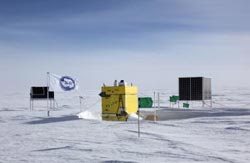Remote Antarctic telescope reveals gas cloud where stars are born

A UNSW-led team has used a telescope in Antarctica to identify a giant gas cloud in our galaxy which appears to be in an early stage of formation. Image is of the PLATO-R observatory at Ridge A. The HEAT telescope is the black object on stilts at left, the instrument module is the yellow box and the solar panel array is on the right.<br><br>Credit: Image: Geoff Sims<br>
Giant clouds of molecular gas – the most massive objects in our galaxy – are the birthplaces of stars.
“This newly discovered gas cloud is shaped like a very long filament, about 200 light years in extent and ten light years across, with a mass about 50,000 times that of our sun,” says team leader, Professor Michael Burton, an astronomer at UNSW Australia.
“The evidence suggests it is in the early stages of formation, before any stars have turned on.”
The results are published in The Astrophysical Journal.
The team is using the High Elevation Antarctic Terahertz telescope, or HEAT, at Ridge A, along with the Mopra telescope at Coonabarabran in NSW, to map the location of gas clouds in our galaxy from the carbon they contain.
At 4000 metres elevation, Ridge A is one of the coldest places on the planet, and the driest. The lack of water vapour in the atmosphere there allows terahertz radiation from space to reach the ground and be detected.
The PLATO-R robotic observatory with the HEAT telescope was installed in 2012 by a team led by UNSW physicist, Professor Michael Ashley, and Dr Craig Kulesa of the University of Arizona.
“We now have an autonomous telescope observing our galaxy from the middle of Antarctica and getting data, which is a stunning new way of doing science. Ridge A is more than 900 kilometres from the nearest people, who are at the South Pole, and is completely unattended for most of the year,” says Professor Burton.
The HEAT telescope detects atomic carbon and the Mopra telescope detects carbon monoxide. “I call it following the galactic carbon trail,” says Professor Burton.
The discovery of the new galactic cloud, which is about 15,000 light years from earth, will help determine how these mysterious objects develop in the interstellar medium.
One theory is that they are formed from the gravitational collapse of an ensemble of small clouds into a larger one. Another involves the random collision of small clouds that then agglomerate. Or it may be that the molecular gas filament is condensing out of a very large, surrounding cloud of atomic gas.
About one star per year, on average, is formed in the Milky Way. Stars that explode and die then replenish the gas clouds as well as moving the gas about and mixing it up.
The team includes researchers from Australia, Germany and the US.
Media contacts:
Professor Michael Burton: +61 (2) 9385 5618, m.burton@unsw.edu.au
UNSW Science media: Deborah Smith: +61 (2) 9385 7307, +61 (0) 478 492 060, deborah.smith@unsw.edu.au
Media Contact
More Information:
http://www.unsw.edu.auAll latest news from the category: Physics and Astronomy
This area deals with the fundamental laws and building blocks of nature and how they interact, the properties and the behavior of matter, and research into space and time and their structures.
innovations-report provides in-depth reports and articles on subjects such as astrophysics, laser technologies, nuclear, quantum, particle and solid-state physics, nanotechnologies, planetary research and findings (Mars, Venus) and developments related to the Hubble Telescope.
Newest articles

High-energy-density aqueous battery based on halogen multi-electron transfer
Traditional non-aqueous lithium-ion batteries have a high energy density, but their safety is compromised due to the flammable organic electrolytes they utilize. Aqueous batteries use water as the solvent for…

First-ever combined heart pump and pig kidney transplant
…gives new hope to patient with terminal illness. Surgeons at NYU Langone Health performed the first-ever combined mechanical heart pump and gene-edited pig kidney transplant surgery in a 54-year-old woman…

Biophysics: Testing how well biomarkers work
LMU researchers have developed a method to determine how reliably target proteins can be labeled using super-resolution fluorescence microscopy. Modern microscopy techniques make it possible to examine the inner workings…





















